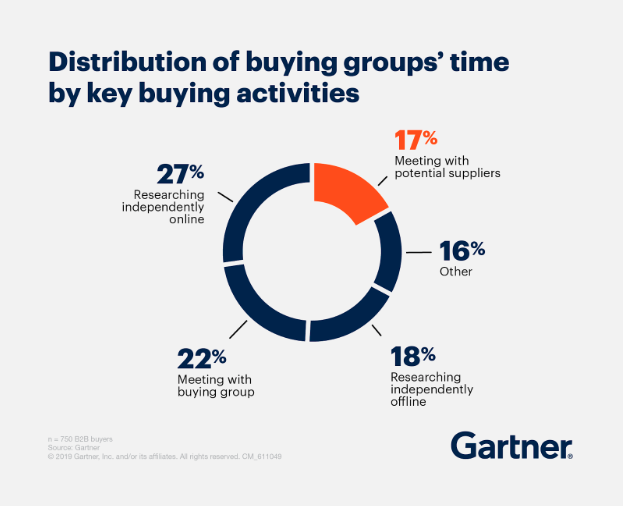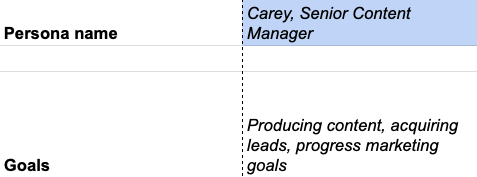A quick Google search for “how much of the buyer’s journey is digital?” brings up a range of perspectives.
The most frequently cited source — a 2013 study by Forrester (FKA SiriusDecisions) — claimed that 67% of the buyer’s journey is now done digitally. Another (equally old) report from Google insisted that B2B buyers don’t reach out to suppliers directly until 57% of the purchase process is complete. You can probably find plenty more figures if you care to look.
But, ultimately, the specific percentage isn’t important.
What really matters is the overall impact of digital content on buying cycles and what it all means from a marketing perspective.
Content Comes Before Sales in the Buying Cycle
Whatever your opinion on how much of the buyer’s journey is digital, it’s crystal clear that prospects are spending more time educating themselves before connecting with sales.
According to Gartner, B2B buyers spend 45% of their “buying time” on independent research and 22% speaking to other members of the buying group, but only 17% on meetings with potential suppliers.
So if your buyer is comparing you against two or three other suppliers, they might only spend 5-6% of total buying time speaking to a sales rep at your organization.
Because buyers are spending so little time talking to sales, it’s become much harder to figure out whether they’re actually in the buying process at any given time. But we have to assume content marketing is going to reach them before sales does.
Which means it’s imperative we have content that supports potential customers at every stage of the buyer journey.
4 Steps for Content Mapping the Buyer Journey
Without a robust content mapping process, it’s all too easy to overlook specific customer personas, pain points, and stages of the sales funnel. That’s why we’ve developed a four-step process for mapping content against the buyer journey:
1. Establish Your Target Customer Persona(s) & Their Pain Points
You might already have a clearly defined set of customer personas, in which case you can jump straight to step #2.
If you haven’t developed your personas, we’re not going to talk you through all the ins and outs here because it can be a pretty lengthy process. But on a basic level, you need to understand two things about your customers:
- Who they are
- What problems they face that would lead them to your product or service (aka, their paint points)
Not sure who your customers are or what they care about? Speak to your sales team at this stage to better understand the types of questions they commonly field from buyers.
2. Map Your Existing Content
Now it’s time for the content mapping to begin. Your task at this stage is to map the content you’ve already created — blog posts, ebooks, case studies, videos, and more — against the different stages of the sales funnel.
Start by creating a content mapping spreadsheet with columns for each stage of the buyer’s journey:
- Increase awareness
- Create interest and desire
- Nurture interest and entice the purchase
- Retain customers and build brand loyalty
Or save yourself the time by using Content Conquered’s FREE content mapping spreadsheet. Simply make a copy of our spreadsheet and input your own information.
Next, create a separate tab for each of your customer personas, then add their name, job role, and goals to the sheet:
Finally, add your existing content titles to the spreadsheet, taking into account the persona, pain point, and sales funnel stage they’re targeting:
(N.B. If a single piece of content targets multiple personas, be sure to include it in each relevant persona tab.)
3. Look for Gaps in Your Content Map
Having copy-pasted all your current titles into the content map, it should become clear which personas, pain points, and funnel stages are targeted by lots of content — and which are a little more sparse.
Maybe you have a ton of top-of-funnel content, but not much in the middle or bottom, and no post-purchase content whatsoever. Or perhaps your content library is heavily geared toward a single buyer problem, with little or nothing targeting other pain points.
Whatever the case, your next task is to plan your future content strategy to ensure you have at least some content available for each funnel stage, customer persona, and buyer problem.
Unless you have near-unlimited content marketing resources, you’ll need to create a priority order.
Chances are, some pain points are more important than others. Perhaps one buyer problem is relevant to all of your customer personas, or maybe some pain points are more closely related to your product or service than others. These are the areas you should be focusing on.
It’s also worth considering funnel stages when prioritizing content production. In our experience, the most important stages for most B2B brands are the middle and bottom of the funnel, where content is most likely to result in meaningful sales conversations. So if you have limited resources, we’d suggest prioritizing content at these stages.
4. Search for Content Amplification & Campaign Opportunities
By this point, you should have a full funnel of content. Next, it’s time to search for additional content amplification and campaign opportunities. This could involve:
- Coordinating with sales. Once you’ve created all that shiny new content, your sales reps need to know it exists, and understand that it’s mapped to specific pain points and funnel stages. That way, they can use it to nurture leads.
- Developing automated email nurture sequences. Email marketing delivers an average return of $36 for every $1 spent, making it a highly efficient way to get your content in front of people opted into your emails.
- Running paid promotions and/or sponsored content campaigns. If you’ve got the budget to spend on paid content promotion, be sure to use it efficiently by amplifying content targeting the middle or bottom of the sales funnel.
Need help creating valuable, buyer-focused content that speaks to specific customer pain points? Got a ton of ideas in your content map, but no internal resources to bring them to life? Get in touch with Content Conquered today to discuss your content creation needs.



